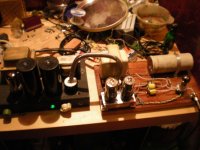Motor run caps are polypropylene. Also often called "film caps". They can be oil filled or not. They come in various qualities, but in general ALL polypropylene caps sound better than all electrolytic caps. If you have room use all polypropylene caps in your PSU. They are bigger, and if you don't have room, the final capacitor in the chain, e.g. CLC, should be polypropylene. I believe this sums up good practice as usually expressed in these forums. No doubt others will advise in more detail.
The motor runs work great, my preference is for oil filled ASC and GE types. Do not confuse these with motor start capacitors which are generally much more compact and contain short lived electrolytic caps not intended for continuous duty.
Preferably purchase ones that have a DC voltage rating in addition to the AC operating voltage. Generally you are safe running them at up to DC values equivalent to the Vpk value represented by the stated rms value.. In many cases the safe DC voltage may be a lot higher than this, but unless disclosed this would be the safest way to go.
In tube amp supplies operated conservatively they will probably outlast you..
Preferably purchase ones that have a DC voltage rating in addition to the AC operating voltage. Generally you are safe running them at up to DC values equivalent to the Vpk value represented by the stated rms value.. In many cases the safe DC voltage may be a lot higher than this, but unless disclosed this would be the safest way to go.
In tube amp supplies operated conservatively they will probably outlast you..
I used two Genteq 97f5211 50 uf 440 VAC film caps, to replace 47 uf 450 VDC rated electrolytic caps in my organ. I have two 5AR4 tube rectifiers. It can be run really loud, particularly the bass. The caps show a 1000 VDC rating stamped on them. Huge, I put them in a separated chassis connected to the original by twinax 18ga cable. Ground shielded one end, plus up and back in the same cable, minus up and back in the other cable. I have 40 ohm chokes (original) between the rectifiers and the caps, 47 ohm 5 watt resistors (not stock) between the transformer and the plates. The load is a pair of 7591 tubes on bass and two pairs of 6BQ5 tubes for the treble, and 17 other tubes for signal processing.
Last edited:
I see that DC = AC peak Vrating in the datasheets - not certain how strongly to believe - it turns out blocking high DC V is much harder on a real world dielectric over time vs AC - and these AC motor run caps really aren't expected to see appreciable DC for their entire working life
Last edited:
its continuous DC bias at higher V that stresses dielectric
if "toughness" is just surviving seconds of transients then its no indication
Higher DC fields drive different degradation/breakdown phenomena to penetrate a dielectric over time - opto isolator WVDC ratings are lots lower than the 1, 60 sec withstand test V because of this
I'm suspicious that maybe the datasheet writers are just doing the AC Vpk math - and may have never tested at 1000s of hrs with DC bias
if "toughness" is just surviving seconds of transients then its no indication
Higher DC fields drive different degradation/breakdown phenomena to penetrate a dielectric over time - opto isolator WVDC ratings are lots lower than the 1, 60 sec withstand test V because of this
I'm suspicious that maybe the datasheet writers are just doing the AC Vpk math - and may have never tested at 1000s of hrs with DC bias
Last edited:
A capacitor rated 440v AC should be OK for 1.4 x that figure in DC, in other words around 600v.
I've seen that rule of thumb as well and given their original intention it seems *fair* but maybe not always relied on.
- Status
- This old topic is closed. If you want to reopen this topic, contact a moderator using the "Report Post" button.
- Home
- Amplifiers
- Power Supplies
- Filter capacitors - motor run?

